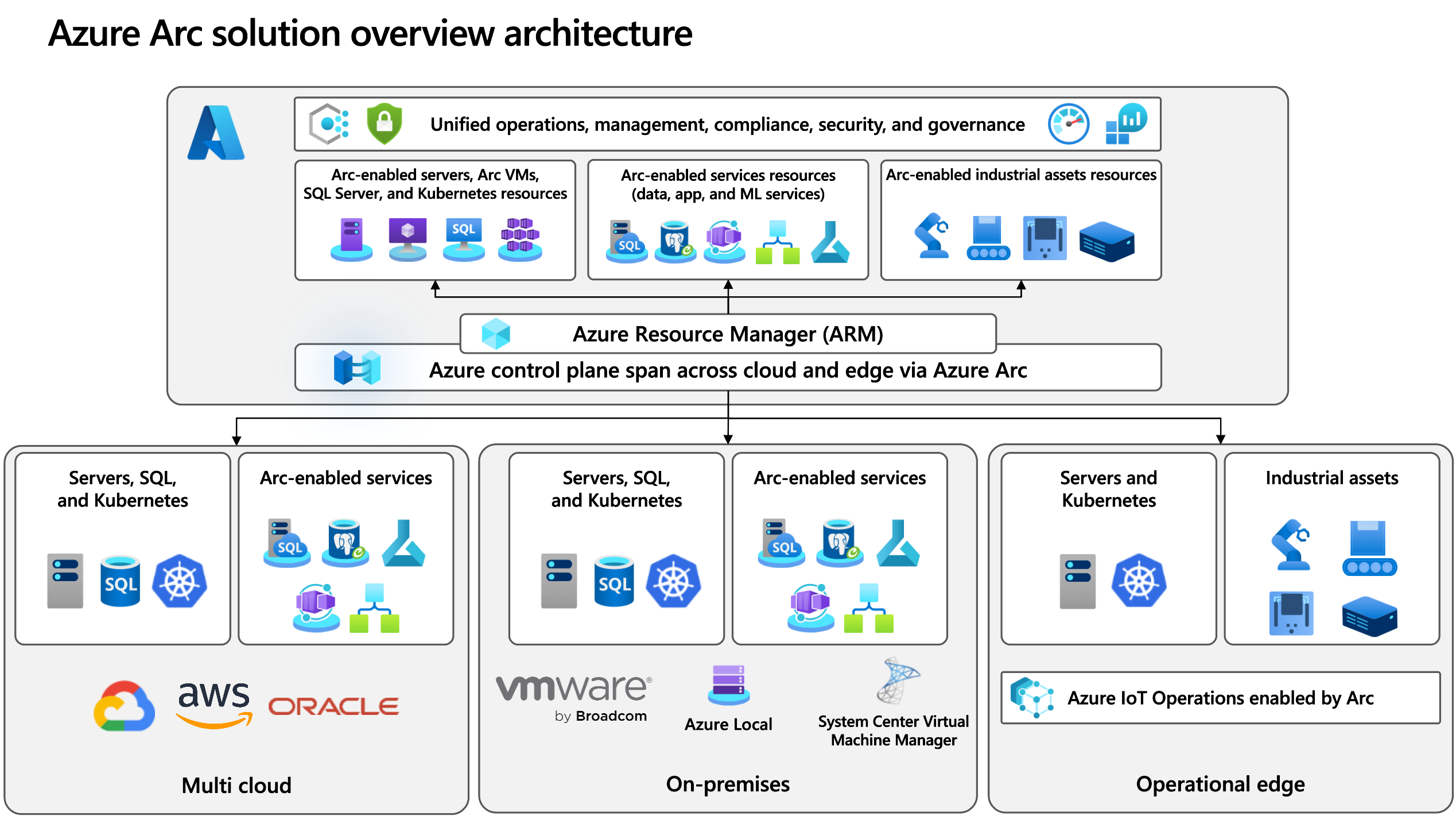What is Azure Arc? Overview, Features, and Use Cases
Azure Arc is a Microsoft service designed to simplify hybrid and multi-cloud infrastructure management in a consistent, secure, and scalable way.
With rapidly evolving technologies, managing resources across environments like AWS, Google Cloud, Azure, and on-premises has become increasingly complex. Azure Arc provides a unified control plane by integrating non-Azure resources into Azure Resource Manager (ARM). This enables centralized governance, policy enforcement, security, and inventory management across your entire IT landscape.
Whether you’re managing VM policies or applying system patches, Azure Arc extends Azure’s native capabilities across hybrid and multi-cloud environments.

Supported Azure Arc Resource Types
- Arc-enabled Servers
- Arc-enabled Kubernetes Clusters
- Arc-enabled Azure Data Services
- Arc-enabled SQL Servers
🔹 Azure Arc-enabled Servers
Azure Arc allows you to onboard and manage Windows and Linux servers running outside Azure (on-premises or other clouds). An agent installed on the server registers it with Azure, making it manageable via the Azure portal and grouping it under a resource group.
🔹 Azure Arc-enabled Kubernetes
Arc lets you connect and manage Kubernetes clusters running inside or outside of Azure. Once connected, clusters support:
- GitOps-based deployment using Flux, enabling continuous delivery.
- Centralized configuration and policy enforcement.
🔹 Azure Arc-enabled Data Services
Run Azure data services such as Azure PostgreSQL or SQL Managed Instance on your infrastructure (on-premises or in other clouds) via Kubernetes. This enables high availability, scalability, and always-updated data workloads in regulated or disconnected environments.
🔹 Azure Arc-enabled SQL Server
Manage and monitor SQL Servers running outside Azure through a single control point in the Azure portal. You can track versioning, licensing, and enforce policy across all SQL environments consistently.
Key Benefits of Azure Arc
Azure Arc extends the Azure management experience to any infrastructure, helping organizations unify operations across hybrid and multi-cloud environments.
1. Unified Management Experience
- Centrally manage infrastructure across Azure, AWS, GCP, on-prem, and edge locations.
- Consistent visibility, tagging, policy enforcement, and lifecycle control via Azure Portal, CLI, or APIs.
2. Azure Services Anywhere
Deploy core Azure services like:
- Azure SQL Managed Instance
- Azure App Services
- Kubernetes-based Data Services
…on any infrastructure, with Azure-native capabilities and support—even in disconnected or regulated environments.
3. Consistent Governance & Security
- Apply Azure Policy, RBAC, Microsoft Defender for Cloud, and Security Center to non-Azure workloads.
- Enforce standardized compliance and security across all environments.
4. Kubernetes & GitOps Integration
- Register and manage Kubernetes clusters regardless of location.
- Implement GitOps-based configuration management using Flux to ensure secure, declarative, version-controlled deployments.
5. DevOps Integration
- Seamless integration with Azure DevOps and GitHub Actions.
- Support for modern CI/CD pipelines and Infrastructure-as-Code (IaC) for hybrid resources.
6. Scalability & Flexibility
- Run Azure services on local infrastructure with full support for autonomous updates and high availability.
- Ideal for disconnected or edge environments (e.g., retail, manufacturing, or military).
7. Cost Optimization
- Benefit from pay-as-you-go pricing for Arc-enabled services.
- Maximize existing infrastructure investments while gaining cloud-native capabilities.
Common Use Cases
- Hybrid Cloud Governance: Apply Azure policies and identity controls across on-prem and other cloud providers.
- Legacy Modernization: Extend DevOps and security tools to traditional VMs and workloads.
- Edge & IoT Management: Deploy Azure services at remote or isolated edge sites.
- Multi-Cloud Operations: Gain visibility and control across AWS, GCP, and Azure.
Learn More
Conclusion
Azure Arc bridges the gap between on-premises, cloud, and edge environments. It provides a single pane of glass for operations, policy, and security—empowering organizations to innovate anywhere while maintaining control and consistency everywhere.